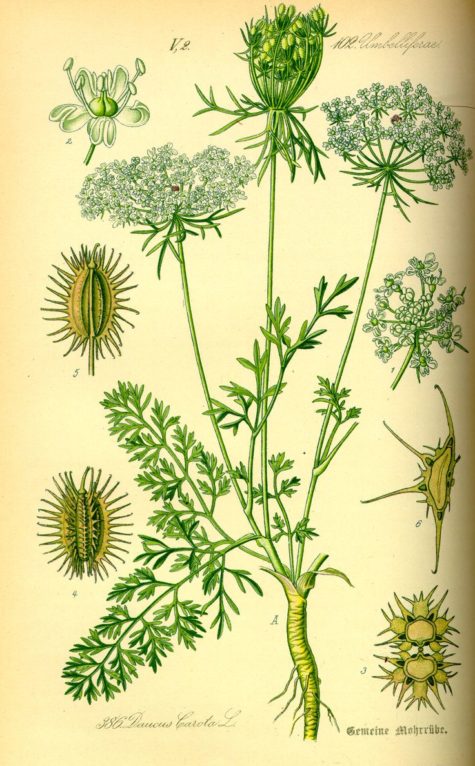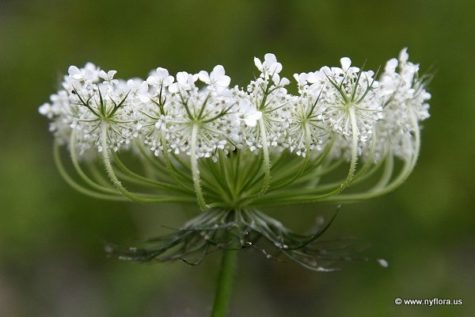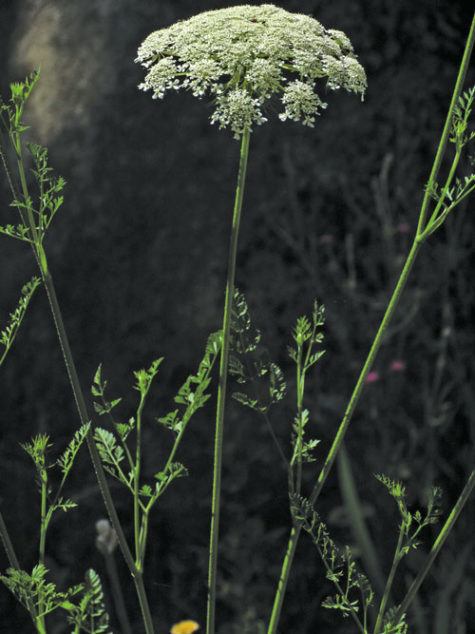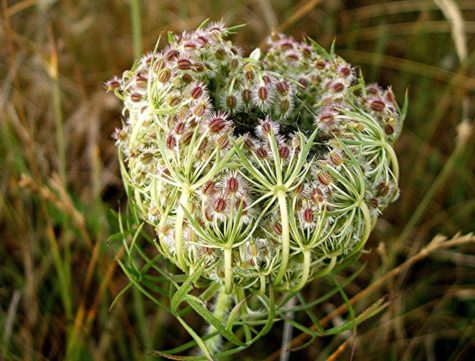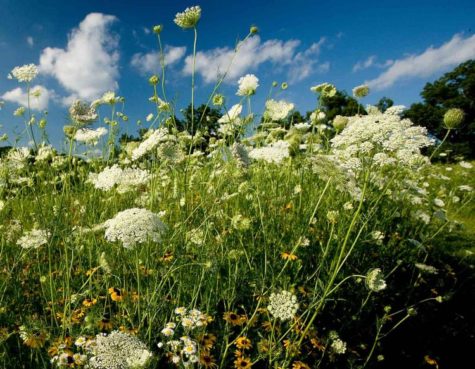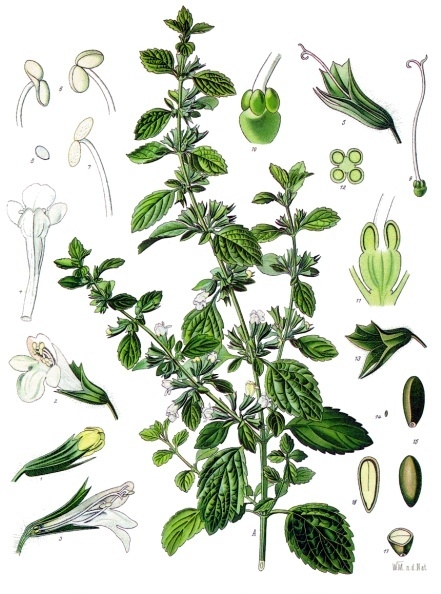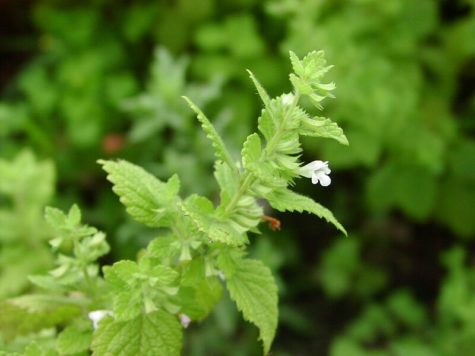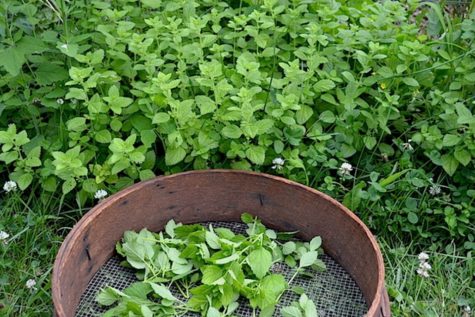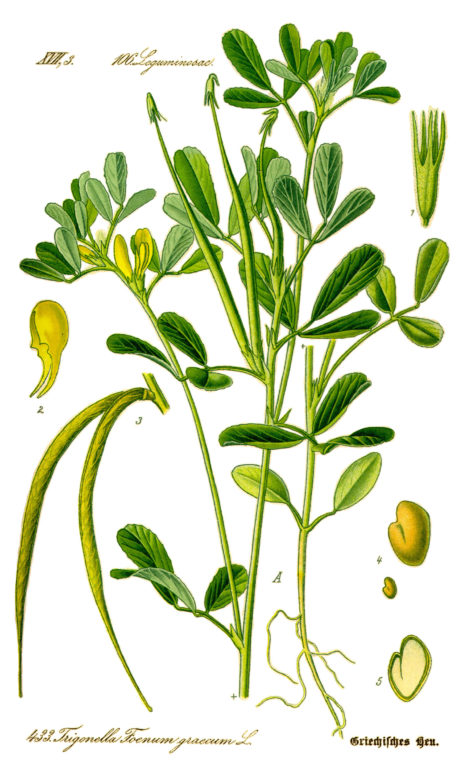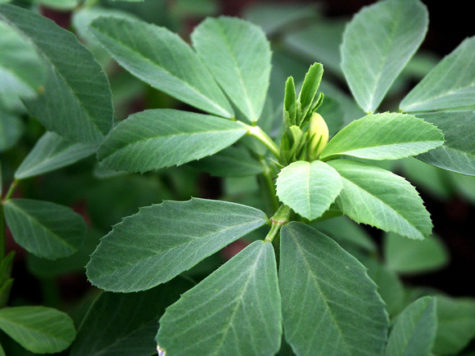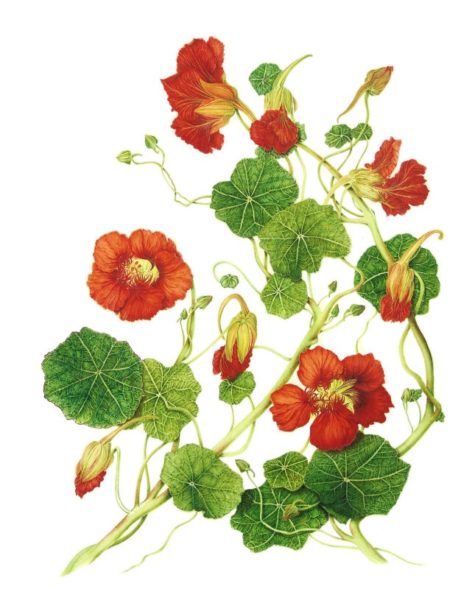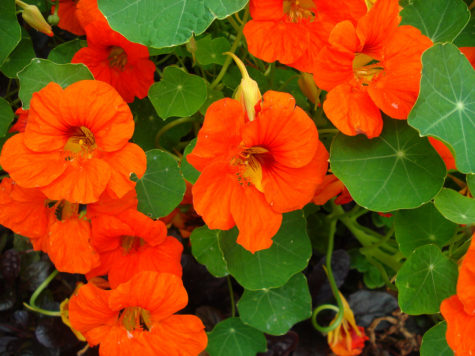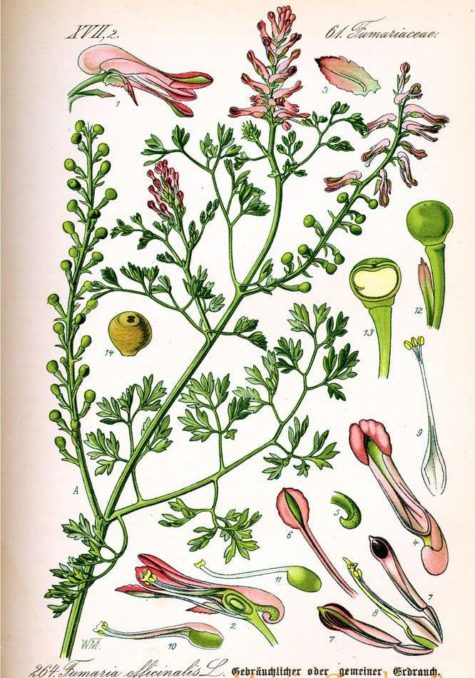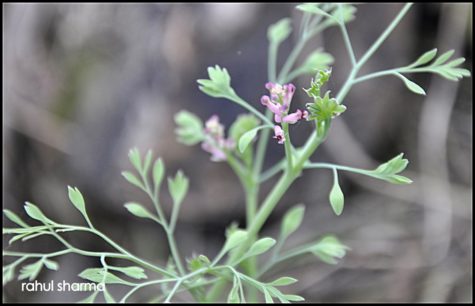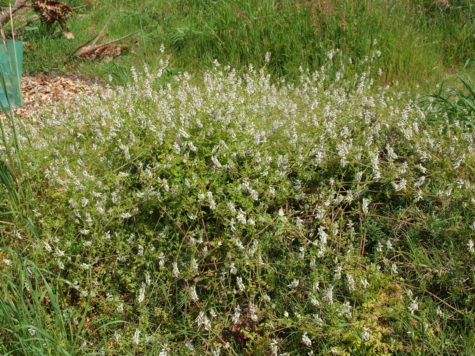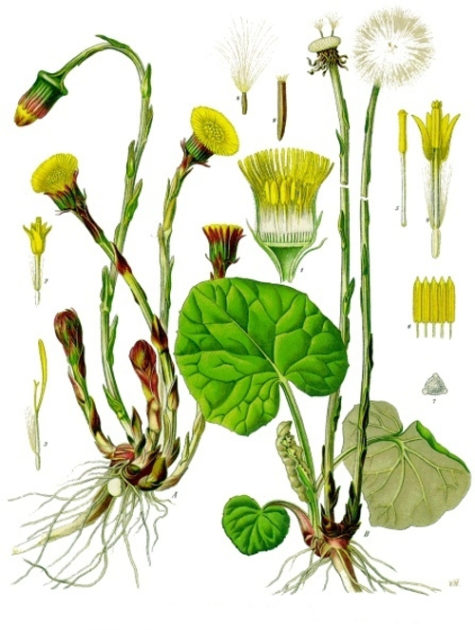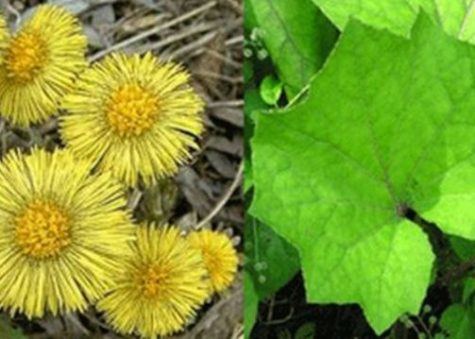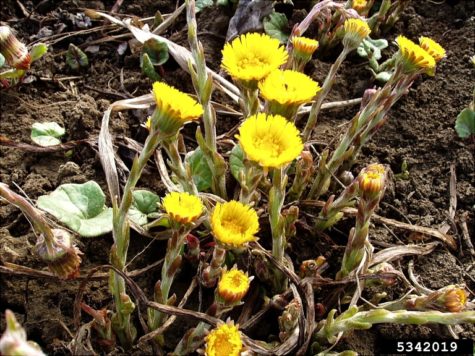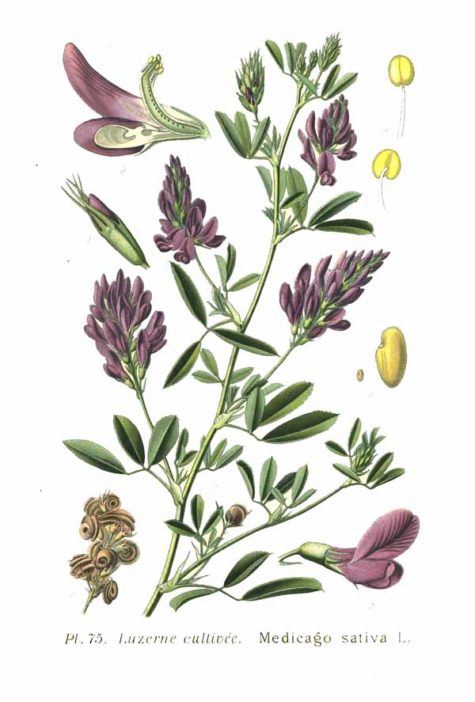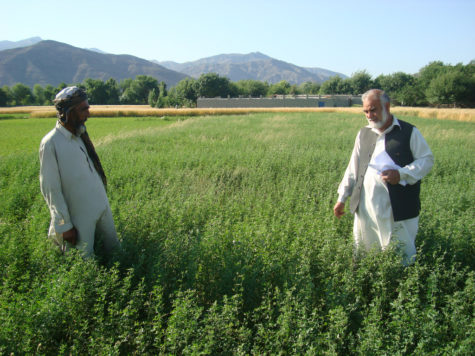Monthly Archives: August 2017
Wild Carrot
- Scientific name: Daucus carota
- Common name: Queen Anne’s Lace
- Plant family: Apiaceae
- Parts used: Whole herb, seeds, root
- Medicinal actions: Diuretic, Anti-lithic, Carminative, Abortifacient, Deobstruent, Emmenagogue
- How does it work? Wild Carrot contains chemicals that might have effects on blood vessels, muscles, and the heart.
General Overview
Wild Carrot, or Queen Anne’s Lace is the wild progenitor of our cultivated carrot. It still has many of the properties lost in cultivation. If an apple a day will keep the Doctor away, legend has it that a Wild Carrot a day might keep death itself away!
The parts that grow above the ground and an oil made from the seeds are used to make medicine. Be careful not to confuse Wild Carrot with the common carrot (which has the familiar orange tap root we eat).
Wild Carrot has been used for centuries as an alternative medicine. It is used for urinary tract problems including kidney stones, bladder problems, water retention, and excess uric acid in the urine; and also for gout, a painful joint problem caused by too much uric acid.
The seed oil is used for severe diarrhea (dysentery), indigestion, and intestinal gas. Women use it relieve pain in the uterus and to start their menstrual periods.
Other uses include treatment of heart disease, cancer, kidney problems, and worm infestations. It is also used as a “nerve tonic” and to increase sexual arousal (as an aphrodisiac).
Constituents
The medicinal properties of the seeds are owing to a volatile oil which is colorless or slightly tinged with yellow; this is procured by distilling with water. They also yield their virtues by infusion to water at 212° F; boiling dissipates them. No thorough analysis has been made.
Description
A pest to farmers, a joy to the flower-lover, and a welcome signal for refreshment to hosts of flies, beetles, bees, and wasps, especially to the paper-nest builders, the sprangly wild carrot lifts its fringy foliage and exquisite lacy blossoms above the dry soil of three continents. From Europe it has come to spread its delicate wheels over our summer landscape, until whole fields are whitened by them east of the Mississippi.
Wild carrot is a biennial plant, and in its second year, from a taproot, the stems grow to a height of two to four feet or more. The stems are erect and branched, generally about 2 feet high, tough and furrowed. Both stems and leaves are more or less clothed with stout coarse hairs. The leaves are very finely divided, the lowest leaves considerably larger than the upper; their arrangement on the stem is alternate, and all the leaves embrace the stem with the sheathing base, which is so characteristic of this group of plants, the Umbelliferae, to which the Carrot belongs.
The two to four inch “flower” is actually a compound of terminal umbels, made up of many small white flowers. The central flower of the Umbelliferae is often purple. A ring of finely-divided and leaf-like bracts grows at the point where the umbel meets the stem. The blossoms are densely clustered together in terminal umbels, or flattened heads, in which the flower-bearing stalks of the head all arise from one point in rays, like the ribs of an umbrella, each ray again dividing in the case of the Carrot, in like manner to form a secondary umbel, or umbellule of white flowers, the outer ones of which are irregular and larger than the others.
The Wild Carrot is in bloom from June to August, but often continues flowering much longer. The flowers themselves are very small, but from their whiteness and number, they form a conspicuous head nearly flat while in bloom, or slightly convex, but as the seeds ripen, the umbels contract, the outer rays, which are to begin with 1 to 2 inches long, lengthening and curving inwards, so that the head forms a hollow cup hence one of the old popular names for the plant – Birds’ Nest.
The fruit is slightly flattened, with numerous bristles arranged in five rows. The ring of finely-divided and leaf-like bracts at the point where the umbel springs is a noticeable feature.
Its root is small and spindle shaped, whitish, slender and hard, with a strong aromatic smell and an acrid, disagreeable taste, very different to the reddish, thick, fleshy, cultivated form, with its pleasant odor and peculiar, sweet, mucilaginous flavor. It penetrates some distance into the ground, having only a few lateral rootlets.
Varieties
The Carrot is well distinguished from other plants of the same order by having the central flower of the umbel, or sometimes a tiny umbellule, of a bright red or deep purple color, though there is a variety, Daucus maritimus, frequent in many parts of the seacoast in the south of England, which differs in having somewhat fleshy leaves and no central purple flower. In this case, all the flowers of the head have usually a somewhat pinkish tinge. There was a curious superstition that this small purple flower of the Carrot was of benefit for mitigating epilepsy.
Habitat
The Carrot was in ancient times much valued for its medicinal properties; the Wild Carrot, which is found so plentifully in Britain, both in cultivated lands and by waysides, thriving more especially by the sea, is superior, medicinally, to the cultivated kind.
Probably originally a native of the sea-coasts of Southern Europe degenerated into its present wild state, but of very ancient cultivation. The name ‘Carrot’ is Celtic, and means ‘red of colour,’ and Daucus from the Greek dais to burn, signifying its pungent and stimulating qualities.
This biennial herb has become naturalized throughout the United States and Canada. Wild Carrot blooms in summer and fall. It thrives best in sun to partial shade. Daucus carota is commonly found along roadsides and in unused fields.
Cautions
Extra caution should be used when collecting Wild Carrot because it bears a close resemblance to poison hemlock. In addition, the leaves of the Wild Carrot may cause phytophotodermatitis, so caution should also be used when handling the plant. It has been used as a method of contraception and an abortifacient for centuries. Continue reading
Lemon Balm
- Scientific Name: Melissa officinalis
- Plant Family: Laviatae
- Parts Used: Leaves – fresh or dried
- Actions: Carminative, Anti-spasmotic, Anti-depressive, Diaphoretic, Hypotensive, Anti-emetic, Hepatic, Nervine, Tonic
- Constituents: Rich in essential oil containing citral, citronellal, geraniol and lindol; bitter principles, flavones, resin.
- How does it work? Lemon balm contains chemicals that seem to have a sedative, calming effect. It might also reduce the growth of some viruses.
General Overview:
A member of the mint family, lemon balm is considered a “calming” herb. It has been used for centuries to help heal wounds, treat venomous insect bites and stings, induce relaxation and a sense of well being, improve appetite and aid digestion. Lemon balm, known and named for its fresh, lemony scent, has long been used as a culinary, cosmetic and medicinal and magical herb.
Note: Lemon Balm, though often called Bee Balm, should not be confused with another plant commonly called Bee Balm (Mondara dydima).
The botanical name, melissa, is Greek for “bee”. Lemon balm has been cultivated in the Mediterranean region for about 2000 years. The Muslim herbalist Avicenna recommended lemon balm “to make the heart merry”. Paracelsus claimed this herb could completely revitalize the body and called it the “elixir of life”, and 14th century French King Charles V drank its tea every day to keep his health.
Lemon balm is used for digestive problems, including upset stomach, bloating, intestinal gas (flatulence), vomiting, and colic; for pain, including menstrual cramps, headache and toothache; and for mental disorders, including hysteria and melancholia.
Lemon balm is excellent for treating anxiety and battling some hard-to-treat viruses. The list of symptoms from anxiety is vast but melissa tackles them all bravely. It is equally fearless when it comes to taking on viruses as daunting as Mono and Herpes. This is an herb every healer wants in the medicine cabinet.
In Ayruvedic medicine, Lemon Balm’s energy is pungent, sour-sweet, cool, and wet. Crushed leaves rubbed on the skin in the garden helps keep away bugs.
Many people believe lemon balm has calming effects so they take it for anxiety, sleep problems, and restlessness. Lemon balm is also used for Alzheimer’s disease, attention deficit-hyperactivity disorder (ADHD), an autoimmune disease involving the thyroid (Graves’ disease), swollen airways, rapid heartbeat due to nervousness, high blood pressure, sores, tumors, and insect bites.
Lemon balm is inhaled as aromatherapy for Alzheimer’s disease. Some people apply lemon balm to their skin to treat cold sores (herpes labialis).
Description:
A familiar garden plant with its fresh, green, nettle shaped leaves and strong bushy growth, lemon balm is native to southern Europe and was probably introduced to the north by the Romans. The creamy flowers are undistinguished and grow in loose clusters from midsummer. The hardy root is perennial.
Lemon balm has the square stems indicative of the mint family with green, oval, finely toothed leaves that grow opposite each other on the stem. The leaves also have fine hairs that capture morning dew and helps keep the plant moist. Flowers are small and yellow to white depending on soil type. It can vary in height between 12 inches to well over 3 feet.
Cultivation:
Easy to grow and tolerant of most soils, it does especially well on a fairly rich, moist ground in a sheltered, sunny position. Sow seeds in the spring or late summer; divide the roots in the fall or early spring; take cuttings in the summer. Keep the plants well weeded.
It prefers moist, not soggy, loamy soil in full sun but will develop more volatile oils when grown in drier, shadier soils. It can tolerate a vast pH range from 5 to 8 in the soil. Lemon balm flowers in the summer and provides an excellent source of nectar for bees and hummingbirds.
Barely cover seed to germinate in 1-2 weeks at room temperature. Set out at 12-15 inches apart in full sun and rich soil. This perennial plant typically gets 12-18 inches tall.
Like any mint, it can be aggressive–it spreads by runners, self-seeds, and can be propagated by cuttings. But it’s a plant, not a monster. I have my lemon balm in partial shade, next to my cabbages and some other aromatic herbs. It has formed some nice thick clumps in two years, but it is not taking over the garden by any means. If you feel concerned, plant it in a pot and sink the pot in the soil.
It is hardy to zone 4: -30°F. It is a good companion plant for members of the brassica family, and deer don’t usually eat it. For drying, harvest leaves just before or after it flowers. Don’t harvest when it’s wet or the leaves will discolor.
Collection
Leaves may be harvested two or three times a year between early summer and early fall. They are gathered by cutting off the young shoots when they are approximately 12 in long. Harvest them for drying as the flowers begin to open. Dry quickly and carefully in the dark, or in the shade, to preserve their color. They should be dried at a temperature not above 95° F.
Unlike other herbs which are at their best when the dew has dried off them in the morning, Lemon Balm should be harvested in mid to late afternoon when the oils are strongest.
Lemon balm can be harvested for fresh use once or twice a week and leaves can be kept in the fridge for a few days, or be frozen. Leaves should be handled delicately as they tend to bruise and turn black.
Hang sprigs to dry in dark cool place. Be sure to keep out of moisture, as leaves are prone to browning and more susceptible to mold. Store dried leaves in air tight container. The leaves lose some of their flavor when dried.
Medicinal Uses
Lemon balm is an excellent carminative herb that relieves spasms in the digestive tract and is used in flatulent dyspepsia. Because of its anti depressive properties, it is primarily indicated where there is dyspepsia associated with anxiety or depression, as the gently sedative oils relieve tension and stress reactions, thus acting to lighten depression.
A little patch of lemon balm in the garden, particularly near the bedroom windows, brings uplifting energy on dark days. We get a lot of cloudy days here in the Pacific Northwest. I’ve found that a bit of lemon balm growing in close proximity to my home brings just enough sunny energy to give my family the lift we need during long spans of dark weather. When the going gets particularly tough, we pick a few sprigs for our drinking water, but most of the time Lemon Balm’s presence is enough. Continue reading
Fenugreek
- Scientific Name: Trigonella foenum-graecum
- Plant Family: Leguminosae
- Parts Used: Seeds
- Medical Actions: Expectorant, Demulcent, Tonic, Galactagogue, Emmenagogue, Emollient, Vulnerary
- Constituents: 30% mucilage, bitter principle, volatile and fixed oil, flavonoids, alkaloids, coumarins, vitamins, and saponins; the most prevalent alkaloid is trigonelline and coumarins include cinnamic acid and scopoletin.
The Basics
Originally from the eastern Mediterranean, cultivated in Europe, Africa and Asia for thousands of years as a fodder plant, a medicine, and a spice, Fenugreek is an herb that has an ancient history. It has great use in local healing and reducing inflammation for conditions such as wounds, boils, sores, fistulas, and tumors.
It can be taken to help bronchitis and gargled to ease sore throats. It’s bitterness explains its role in soothing disturbed digestion.
The seeds are rich in vitamins, nitrates and calcium, have a softening soothing action and are said to encourage lactation. It is a strong stimulator of milk production in nursing mothers, for which it is perfectly safe, and also has a reputation for stimulating development of the breasts.
In traditional medicine, Fenugreek is thought to promote digestion, induce labour, and reduce blood sugar levels in diabetics.
Description
It is an annual and grows about 2 ft high with yellowish peaflowers in midsummer, trifoliate leaves and long narrow pods containing at least 10 square seeds, reaching maturity in a few months in warm climates. It is tender in temperate climates.
It is an annual, erect, robust aromatic herb which grows up to a height of 60 cm. it has compound leaves around 5 cm in length, with long pedicles. The leaflets are obovate, around 2.5 cm long and the margins are slightly toothed. Flowers are seen in pairs or single, axillary and yellow in color. Fruits of the plant are leguminous pods around 5-8 cm long, with a persistent beak, narrow and enclose 10-20 golden yellow seeds which have a typical savory aroma.
Cultivation and Harvesting
Fenugreek is a fairly fragile annual that has a visual similarity to clover. Preferring rich soils and requiring full sun, it grows from one to two feet in height and blooms in smallish white flowers during midsummer.
The primary caution in planting Fenugreek is an awareness of soil temperature. It must have a soil temperature of at least 55°F to germinate, in colder or very damp soils the seeds will rot, and the plant itself will be prone to root rot even when older.
Harvest the seeds when the pods are ripe, but just before they open. Remove the seeds from the pods and dry them naturally in the sun
Medicinal Uses
Fenugreek is a herb which is bitter to taste and increases lactation, soothes tissues which are irritated, stimulates uterus, reduces fever, blood sugar, improves digestion, improves relieving capacity and works as an expectorant, diuretic, laxative, anti-tumour and anti-parasitic effects. Fenugreek relieves diabetes, poor digestion, tuberculosis, gastric inflammation and digestive disorders.
Fenugreek acts as a reliever for many ailments, here is a quick list:
- Cholesterol: It is a proven fact that by consuming Fenugreek cholesterol can be balanced. Around 2 ounces can be taken every day.
- Diabetes: Fenugreek is effective in relieving Type 2 diabetes. Consumption of around 500 mg Fenugreek every day will yield the desired results.
- Skin inflammation: Fenugreek is very effective in relieving burns, boils, abscesses, gout and eczema. Fenugreek powder should be made into a paste with water and a cloth should be soaked into this paste. The soaked cloth can be applied on the affected area of the skin as a poultice.
- Heartburn and Acid Reflux: Seeds of Fenugreek contain mucilage which help is soothing gastrointestinal inflammation. It coats the lining of the intestine and stomach. Hence it works effectively against acid reflux and heartburn. Around 1 teaspoon Fenugreek seeds can be swallowed along with water before meal.
- Fever: This herb is useful for reducing fever. The seeds should be consumed along with honey and lemon.
- Breast enlargement: Fenugreek balances female hormones. It should be consumed up to 3g every day.
- Child Birth problems: Fenugreek stimulates uterine contractions and is helpful in inducing childbirth. But pregnant women should use this remedy only after consulting the doctor.
- Lactation: Fenugreek influences milk production in nursing mothers.
Nasturtium
- Scientific name: Tropacolum majus
- Plant family: Tropaeolaceae
- Note: It should not be confused with watercress, whose Latin name is Nasturtium officinale.
- Parts Used: The fresh or dried leaves, flowers, and the seed pods.
- Medical Action: Anti-microbial, anti-bacterial, anti-viral
- Constituents: Glucosilinates; unknown anti-bacterial substance, vitamin C
The flowers contain about 130 mg vitamin C per 100 grams (3.5 oz), about the same amount as is contained in parsley. Moreover, they contain up to 45 mg of lutein per 100 gr, which is the highest amount found in any edible plant.
The Basics
Nasturtium is quite a powerful anti-microbial, especially when used as a local remedy for the treatment of bacterial infection. Internally it can be used with benefit in any bacterial infection but it is especially indicated for respiratory infections suchas bronchitis.
It has been found to be beneficial in influenza and the common cold. Some herbalists report it to be indicated in infections of the female reproductive organs.
Nasturtium is mostly taken fresh by adding leaves, flowers and seed pods into salads and other edibles. The plant is antimicrobial, so it is good to eat this herb for infections. It is useful for respiratory infections like bronchitis, flu and colds, and it is also helpful for reproductive infections. It can help clear mucous from the throat and lungs.
By taking herbal tincture when you first feel a cold coming on, you can help speed that cold on its way. The seed pods may be antifungal. Tinctures can be made in alcohol or vinegar to preserve the nutrients of the plant for later use. Vinegar can be put on cooked greens for a mustardy touch.
The mustard oils contained in nasturtium have an antibacterial and antiviral effect and can protect against infectious and undesired yeasts such as candida. They can be used to relieve pain, improve wound healing, treat digestive disorders and bladder infections and infections of the upper respiratory tract.
Description
Nasturtium is found in many gardens with its round flat leaves and bright cheery flowers. It comes in many different colors and some varieties have variegated leaves as well.
Nasturtium is both a decorative garden annual as well as a useful culinary herb. There are two types of nasturtium; a trailing type (Tropaeolum majus) that can be trained to climb or allowed to spread on the ground and a bush type (Tropaeolum minus) that forms loose mounds.
Nasturtium produces colorful flowers all summer and has attractive water lily-like foliage. It is useful as a plant for garden beds as well as for containers. The big beautiful flowers and leaves with their unusual shield-like shape are particularly striking and ornamental. The plant forms up to 4 m long shoots that bear flowers throughout the year.
Because it is not hardy, all this splendor sadly ends with the first frost. Continue reading
Fumitory
- Scientific name: Fumaria officinalis
- Family: Fumariaceae
- Medical Action: Laxative, alterative, cholagogue, hepatic, diuretic, and aperient, a weak tonic, slightly diaphoretic,
- Constituents: Alkaloids, bitter principle, mucilage, fumaric acid, amino acids, resin. The plant contains isoquinoline alkaloids protopine and allocryptopine.
- Parts Used: Leaves
- Other Fumitories: American Fumitory Fumaria Indica, or Codder Indian
The Basics
Earth smoke, as it is also called, is a wild poppy plant traditionally used as an incense herb with a stimulating effect on liver and gallbladder and as a protection against skin diseases and eczema. The drug fumitory is toxic in high doses.
Fumitory has been known since antiquity and was described in herbals from the Middle Ages. Fumitory is a predominantly Mediterranean genus that once was used medicinally. Traditional preparation involved expressing the juice and evaporating it. It has been used as a laxative and diuretic.
Fumaria species are used in Turkish folk medicine as a blood purifier and an anti-allergic agent.
In traditional medicine, the plant has been used to treat eczema and other dermatologic conditions. It was thought to be good for the eyes, and to remove skin blemishes. In modern times herbalists use it to treat skin diseases, and conjunctivitis; as well as to cleanse the kidneys.
Fumitory has a long history of use in the treatment of skin problems such as eczema and acne. Its action is probably due to a general cleansing mediated via the kidneys and liver. Fumitory may also be used as an eyewash to ease conjunctivitis.
The name is said to be derived either from the fact that its whitish, blue-green colour gives it the appearance of smoke rising from the ground, or, according to Pliny, because the juice of the plant brings on such a flow of tears that the sight becomes dim as with smoke, and hence its reputed use in affections of the eye.
Constituents
The leaves yield by expression a juice which has medicinal properties. An extract, prepared by evaporating the expressed juice, or a decoction of the leaves, throws out upon its surface a copious saline efflorescence. Fumaric acid was early identified as present, and its isomerism with maleic acid was established later.
The alkaloid Fumarine has been believed to be identical with corydaline, but it differs both in formula and in its reaction to sulphuric and nitric acids. It occurs in colourless, tasteless crystals, freely soluble in chloroform, less so in benzine, still less so in alcohol and ether, sparingly soluble in water.
Etymology
The “smoky” or “fumy” origin of its name comes from the translucent color of its flowers, giving them the appearance of smoke or of hanging in smoke, and the slightly gray-blue haze color of its foliage, also resembling smoke coming from the ground, especially after morning dew.
The plant was already called fūmus terrae (smoke of the earth) in the early 13th century, and two thousand years ago, Dioscorides wrote in De Materia Medica and Pliny the Elder in Naturalis Historia that rubbing the eyes with the sap or latex of the plant causes tears, like acrid smoke (fūmus) does to the eyes. Continue reading
Coltsfoot
- Scientific name: Tussilago Farfara
- Family: in the groundsel tribe of the daisy family Asteraceae
- Recommended variety: Tussilago farfara ‘Wien’
- Parts Used: Leaves, flowers, root.
- Medicinal Actions: Demulcent, expectorant, tonic, antitussive, anticatarrhal, diuretic, emollient, pectoral.
- Constituents: All parts of the plant abound in mucilage, and contain inulin, zinc, a little tannin and a trace of a bitter amorphous glucoside. The flowers contain also a phytosterol and a dihydride alcohol, Faradial, and carotene
Cautions:
Coltsfoot root contains tumorigenic pyrrolizidine alkaloids and it suspected that there may be small quantities in the leaves. There are documented cases of coltsfoot tea causing severe liver problems in an infant, and in another case, an infant developed liver disease and died because the mother drank tea containing coltsfoot during her pregnancy. In response the German government banned the sale of coltsfoot. Clonal plants of colstfoot free of pyrrolizidine alkaloids were then developed in Austria and Germany. This has resulted in the development of the registered variety Tussilago farfara ‘Wien’ which has no detectable levels of these alkaloids.
The Basics:
The coltsfoot is another wonderful remedy for coughs and colds, whooping cough and shortness of breath. It has a little yellow flower that smells of honey and blooms in February, long before the leaves which grow to enormous size.
Coltsfoot grows nearly everywhere, on rubble heaps, by the side of newly-made roads, on railway banks and on coal mine tips. In fact there is a very old gypsy saying that wherever coltsfoot grows freely, coal will be found. Once it was so revered in France that coltsfoot flowers were painted as a sign on the doorpost of apothecarie’s shops to let people know that the art of healing was practiced there.
Coltsfoot combines a soothing expectorant effect with an antispasmodic action. There are useful levels of zinc in the leaves. This mineral has been shown to have marked anti-inflammatory effects. Coltsfoot may be used in chronic or acute bronchitis, irritating coughs, whooping coughs and asthma. Its soothing expectorant action gives coltsfoot a role in most respiratory conditions, including the chronic state of emphysema.
The Romanies praise this herb very highly. It also has been a part of Chinese folk medicine for centuries.
A decoction of the leaves of the herb coltsfoot to a pint of boiling water (strain before drinking) is very good for colds, coughs and asthma. If you haven`t time to make a decoction when a cough is bad, use an infusion of coltsfoot and take in teacupful dose. It can be sweetened to taste with honey.
As a mild diuretic it has been used in cystitis.
An infusion or juice from fresh leaves can be used as an antiseptic wash for wounds and skin blemishes. The fresh bruised leaves can be applied to boils, abscesses and suppurating ulcers as a poultice, (enclosed in fine muslin to prevent skin irritation)..
Description
Coltsfoot is a low-growing perennial with fleshy, woolly leaves. A member of the daisy family, coltsfoot produces a single golden-yellow flower head that blooms in spring. As the stem dies, the leaves appear. It has long-stalked, hoof-shaped leaves, about 4 inches across, with angular teeth on the margins. The top of the leaf surface is smooth and almost waxy in appearance, while the underside is covered with white, wool-like hairs. Both surfaces of the leaves are covered, when young, with loose, white, felted woolly hairs, but those on the upper surface fall off as the leaf expands.
The bright yellow flowers appear early in the spring, prior to the emergence of any leaves. In Southern Ontario, coltsfoot flowers in April, often before the last of the snow melts. Flower heads have even been known to push through snow. Some people confuse these flowers with dandelion flowers.
The specific name of the plant is derived from Farfarus, an ancient name of the White Poplar, the leaves of which present some resemblance in form and color to those of this plant. There is a closer resemblance, however, to the leaves of the Butterbur, which must not be collected in error; they may be distinguished by their more rounded outline, larger size and less sinuate margin.
An old name for Coltsfoot was Filius ante patrem (the son before the father), because the star-like, golden flowers appear and wither before the broad, sea-green leaves are produced.
The root is spreading, small and white, and has also been used medicinally. The underground stems preserve their vitality for a long period when buried deeply, so that in places where the plant has not been observed before, it will often spring up in profusion after the ground has been disturbed. In gardens and pastures it is a troublesome weed, very difficult to get rid of.
The plant is so dissimilar in appearance at different periods that both Gerard and Parkinson give two illustrations: one entitled ‘Tussilago florens, Coltsfoot in floure,‘ and the other ‘Tussilago herba sine flore.’
‘Coltsfoot hath many white and long creeping roots, from which rise up naked stalkes about a spanne long, bearing at the top yellow floures; when the stalke and seede is perished there appeare springing out of the earth many broad leaves, green above, and next the ground of a white, hoarie, or grayish colour. Seldom, or never, shall you find leaves and floures at once, but the floures are past before the leaves come out of the ground, as may appear by the first picture, which setteth forth the naked stalkes and floures, and by the second, which porttraiteth the leaves only.’
Pliny and many of the older botanists thought that the Coltsfoot was without leaves, an error that is scarcely excusable, for, notwithstanding the fact that the flowers appear in a general way before the leaves, small leaves often begin to make their appearance before the flowering season is over.
Habitat and Cultivation
Coltsfoot, for all its beauty, tends to like rough places to hang out. Seek it in waste ground, building sites, roadsides, the edge of woods, remembering that it has a preference for heavy clay.
Coltsfoot grows abundantly throughout England, especially along the sides of railway banks and in waste places, on poor stiff soils, growing as well in wet ground as in dry situations. The plant is native to Europe, but also grows widely throughout the United States and Canada.
Coltsfoot is found in open, disturbed areas. It often grows in ditches, along roadsides, on forest edges and on steep slopes prone to landslides. It tolerates wet, poorly drained areas and riverbanks susceptible to spring flooding.
Coltsfoot is collected widely from wild plants in the Balkans, Eastern Europe (Bulgaria, Czechoslovakia, Hungary, Poland, the former Yugoslavia), and Italy.
Collection
After the leaves have died down, the shoot rests and produces in the following February a flowering stem, consisting of a single peduncle with numerous reddish bracts and whitish hairs and a terminal, composite yellow flower, whilst other shoots develop leaves, which appear only much later, after the flower stems in their turn have died down.
These two parts of the plant, both of which are used medicinally, are, therefore, collected separately and usually sold separately.
The flowers should be gathered before they have fully bloomed (end of late winter to mid-spring) and dried carefully in the shade. The leaves are best collected between late spring and early summer. They should be chopped up before they are dried and stored. The fresh leaves can be used until Fall.
Medicinal Uses
Demulcent, expectorant and tonic. One of the most popular of cough remedies. The botanical name, Tussilago, signifies ‘cough dispeller,’ and Coltsfoot has justly been termed ‘nature’s best herb for the lungs and her most eminent thoracic.’
As part of its Latin name Tussilago implies, coltsfoot is reputed as an antitussive. The buds, flowers, and leaves of coltsfoot have been long used in traditional medicine for dry cough and throat irritation. The plant has found particular use in Chinese herbal medicine for the treatment of respiratory diseases, including cough, asthma, and acute and chronic bronchitis. Continue reading
Alfalfa
- Scientific Name: Medicago sativa
- Plant Family: Fabaceae
- Parts Used: The leaves, sprouts, and seeds.
- Actions: anti-anemic, appetizer, diuretic, galactagogue, laxative, nutrient, tonic.
- Qualities: Neutral thermal nature; Bitter flavor; Dries dampness, Spring, Yin
The basics:
Alfalfa follows the doctrine of signatures: its ability to produce exceptional roots benefits our “roots,” which are often identified physiologically as our intestines and kidney/bladder functions. Alfalfa cleans and tones the intestines and takes harmful acids out of the blood. It benefits the urinary system and intestines and detoxifies the body.
Alfalfa contains eight enzymes which help assimilate protein, fats, and carbohydrates. It is safe food even for children and helps nursing mothers produce more milk.
In ancient India, Ayurvedic texts prescribe the use of Alfalfa seeds and sprouts for improving blood cell production and its leaves and stem as a good source of protein and minerals.
Nutritional Value:
Alfalfa is rich in chlorophyll, carotene, protein, calcium and other minerals, vitamins in the B group, vitamin C, vitamin D, vitamin E, and vitamin K. Other important nutrients include iron, magnesium, potassium, phosphorus, sodium, sulfur, silicon, chlorine, cobalt, and zinc. Alfalfa also contains vitamins K and P, and abundant chlorophyll.
The sun-dried hay of alfalfa has been found to be a source of vitamin D, containing 48 ng/g (1920 IU/kg) vitamin D2 and 0.63 ng/g (25 IU/kg) vitamin D3. There is also reference to vitamin D2 and vitamin D3 being found in the alfalfa shoot.
Medicinal uses:
Alfalfa is used medicinally in a variety of ways, depending on the country, culture, and healing tradition.
- In China it is considered to have the following qualities: Anodyne, Depurative, Emetic and is used to treat Fever, Gravel, and Dysuria.
- In Iraq it is commonly used to treat Arthritis.
- In Turkey, in addition to treating Arthritis, it is considered to be a Cardiotonic and used to treat Scurvy.
- In the United States it is believed to be Cyanogenetic, and used in the treatment of and prevention of Cancer.
- Elsewhere it is used to treat Arthritis, Boils, as an Emmenagogue, Lactagogue, and for Scurvy.
Note: In this day and age of global information via the internet and social media, these dividing lines have become increasingly blurred.
Alfalfa is used for kidney conditions, bladder and prostate conditions, and to increase urine flow. It is also used for high cholesterol, asthma, osteoarthritis, rheumatoid arthritis, diabetes, upset stomach, and a bleeding disorder called thrombocytopenic purpura. People also take alfalfa as a source of vitamins A, C, E, and K4; and minerals calcium, potassium, phosphorous, and iron.
Other uses include edema, weight loss, bladder stones, plantar warts, chronic sore throat, fevers, gas pains, peptic ulcers, drug and alcohol addiction recovery.
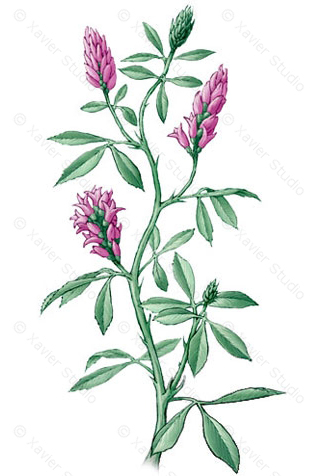 Alfalfa is helpful for chronic joint inflammation and aiding female hormonal balance. It comforts and strengthens the immune system. Alfalfa is rich in vitamins, minerals and other nutrients that play an important role in the maintenance of a healthy body. It contains protein, vitamin A, vitamin B1, vitamin B6, vitamin C, vitamin E, and vitamin K. It also contains calcium, potassium, carotene, iron and zinc and is considered one of the healthiest plant foods, providing an excellent range of nutritive properties for good health and well being.
Alfalfa is helpful for chronic joint inflammation and aiding female hormonal balance. It comforts and strengthens the immune system. Alfalfa is rich in vitamins, minerals and other nutrients that play an important role in the maintenance of a healthy body. It contains protein, vitamin A, vitamin B1, vitamin B6, vitamin C, vitamin E, and vitamin K. It also contains calcium, potassium, carotene, iron and zinc and is considered one of the healthiest plant foods, providing an excellent range of nutritive properties for good health and well being.
Interestingly, alfalfa is a treatment hay fever. Externally the seeds can be made into a poultice for boils, to soothe insect bites, and reduce inflammation. It alkalizes and detoxifies the body. Binds carcinogens in the colon to help speed up their elimination from the body.It is an overall tonic for general health, fatigue, weight gain, and debility. Alfalfa also stimulates the growth of supportive connective tissue, and is useful in the treatment of diabetes.
Alfalfa is a herb rich in protein and the vitamins A, D, E and K. The leaves contain eight of the essential amino acids.Such a a nutrient-rich formula, can be used to replenish the body with vitamins and minerals. It is specifically indicated for those with poor diets and inadequate nutrient intake.
Daily Dosages:
In addition to alfalfa sprouts found in most supermarkets, alfalfa is available as a dried leaf herb, in tablets, capsules, and powders.
- 2 to 3 cups tea
- 2 to 4 grams in capsules or pills 3 times a day
- 6 to 12 grams powder
- 3 ounces sprouts
To make tea, steep 1 tablespoon seed or 2 ounces dried leaf in 1 quart boiling water. In powder form, the pleasant taste of alfalfa is a welcome addition to soups and salads.
For high cholesterol: a typical dose is 5 to 10 grams of the herb, or as a steeped strained tea, three times a day. 5 to 10 mL of a liquid extract (1:1 in 25% alcohol) three times a day has also been used.
Herbal Combinations:
To get more natural vitamins, combine Alfafa with herbs such as Nettle and Rosehip, Nettle is high in both vitamin C and Iron, thus ensuring that energy levels and prevention of cellular damage is assisted. Nettles acts as a blood tonic with the ability to strengthen the body’s natural resistance. Rosehip is also extremely high in vitamin C and is one of the best herbs used for its antioxidant action on the body. It also assists with maintaining healthy collagen.
Cosmetic Uses:
Alfalfa extract (Medicago Sativum Extract) can be an antioxidant in skin-care products, it is said this extract is a great source of protein, minerals and vitamins C,D,E,K for the skin. Conditions and increases skin metabolism to promote skin healing,used as a topical skin conditioner.Alfalfa Extract is primarily used in manufacture of natural face masks and lotions. Saponins in alfalfa extract acts as natural foaming agent. Boots, Clarins and Lancome are using alfalfa extract in their skincare products. Continue reading
Rennie Luttrull: queen-annes-lace-seeds
Rosanna: Spignel aka Bald Money
Annamarie Squatrito: Fumitory
EILEEN Klinghagen: Pumpkin
Mahmudul Hasan: Celery
